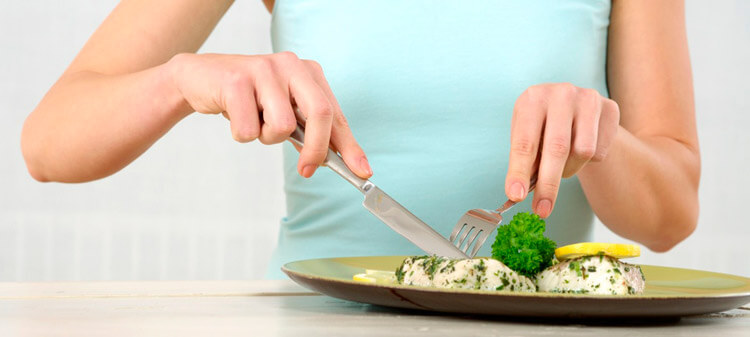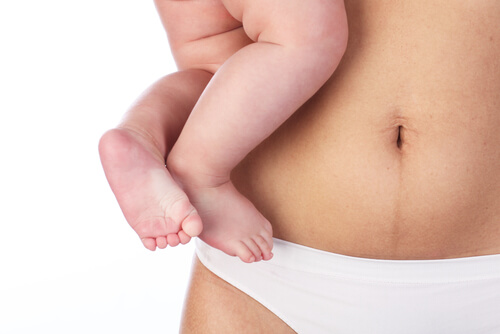How to Get a Flat Stomach after Giving Birth

Many women worry about how to get a flat stomach after giving birth. The baby bump tends to outstay its welcome.
After you give birth, your abdomen may remain soft and rounded due to the natural growth of the uterus, the stretching of the skin and the accumulation of fat reserves.
Your whole body will take time to return to its pre-pregnancy state. The abdomen is no exception.
Slowly, your body will eliminate the liquid it retained, and fat reserves will start to diminish.
Some new moms get back in shape in just a few days. But these lucky women are few and far between.
Most women will take several months to lose the baby bump entirely. There are a few things you can do to speed up this process, however.
Breastfeeding your baby will help you lose weight after giving birth
Breastfeeding soon after giving birth sends a signal to the uterus to shrink. As your womb contracts, your abdomen will start to flatten out.
What’s more, breastfeeding your child burns additional calories, helping you shed the pregnancy pounds.
The process of making milk and feeding your baby is like an extra workout for your whole body.
“After birth, your body will eliminate the liquid it retained, and fat reserves will start to diminish”
Diet for a flat stomach after birth
A balanced diet is always the best weight-loss tip. The best thing you can do is speak to a dietician or nutritionist, who will determine the best meal plan for you.
If you’re breastfeeding, avoid starting a strict diet for two or three months after giving birth. Your body needs the fat it built up during pregnancy to make milk for your baby.
A diet rich in fruit, vegetables and protein is healthy and will help you achieve a flat stomach after giving birth. Reducing carbohydrate intake also works for many people.
Don’t get too hung up on counting calories, though. With a new baby around, you’ll need plenty of energy and good spirits, so make sure your body gets the nourishment it needs.

Fluid retention and abdominal bloating
Retaining extra liquid can give the body a swollen, bloated look. The good news is that there are two simple things you can do to fight fluid retention:
- Reduce your salt intake. Salt keeps liquid in your body unnecessarily. What’s more, it can contribute to high blood pressure. Cutting down on salt in your diet isn’t just good for losing weight after birth, but also for your health in general.
- Drink more water. Although it might seem counterintuitive, drinking plenty of water helps stop your body from retaining fluids, as well as keeping you properly hydrated.
Exercises for a flat stomach after giving birth
The advice above can be very useful, but it isn’t always enough. If time goes by and you’re still carrying a few extra pounds, physical exercise will help you get back into shape.
Aim to exercise for at least three hours a week.
Women can begin exercising around six weeks after giving birth. If you’re trying to lose the baby bump, your fitness regime should be designed to strengthen and tone your core.
- Disciplines like yoga and pilates have become popular among new moms. These are low-impact activities based on holding certain poses that promote flexibility and proper breathing.

This kind of exercise strengthens the core and tones the pelvic and abdominal muscles, making it a great place to start if a flat stomach after giving birth is your goal.
Since these activities aren’t too exhausting, they can fit into your daily routine with your baby.
- Walking and jogging can lead to good results in very little time. Try to walk briskly or jog for 45 minutes three times a week. If you can manage to do it daily, your progress will be even faster.
- Abdominal exercises. Focused exercises like crunches and sit-ups tone the abdominal muscles.
“Women can begin exercising around six weeks after giving birth”
Little by little, your stomach should start to become firmer. If it takes time to get back into shape, don’t let this ruin your enjoyment of motherhood.
Having a baby is a beautiful, natural process, and all the effort will be worth it.
Many women worry about how to get a flat stomach after giving birth. The baby bump tends to outstay its welcome.
After you give birth, your abdomen may remain soft and rounded due to the natural growth of the uterus, the stretching of the skin and the accumulation of fat reserves.
Your whole body will take time to return to its pre-pregnancy state. The abdomen is no exception.
Slowly, your body will eliminate the liquid it retained, and fat reserves will start to diminish.
Some new moms get back in shape in just a few days. But these lucky women are few and far between.
Most women will take several months to lose the baby bump entirely. There are a few things you can do to speed up this process, however.
Breastfeeding your baby will help you lose weight after giving birth
Breastfeeding soon after giving birth sends a signal to the uterus to shrink. As your womb contracts, your abdomen will start to flatten out.
What’s more, breastfeeding your child burns additional calories, helping you shed the pregnancy pounds.
The process of making milk and feeding your baby is like an extra workout for your whole body.
“After birth, your body will eliminate the liquid it retained, and fat reserves will start to diminish”
Diet for a flat stomach after birth
A balanced diet is always the best weight-loss tip. The best thing you can do is speak to a dietician or nutritionist, who will determine the best meal plan for you.
If you’re breastfeeding, avoid starting a strict diet for two or three months after giving birth. Your body needs the fat it built up during pregnancy to make milk for your baby.
A diet rich in fruit, vegetables and protein is healthy and will help you achieve a flat stomach after giving birth. Reducing carbohydrate intake also works for many people.
Don’t get too hung up on counting calories, though. With a new baby around, you’ll need plenty of energy and good spirits, so make sure your body gets the nourishment it needs.

Fluid retention and abdominal bloating
Retaining extra liquid can give the body a swollen, bloated look. The good news is that there are two simple things you can do to fight fluid retention:
- Reduce your salt intake. Salt keeps liquid in your body unnecessarily. What’s more, it can contribute to high blood pressure. Cutting down on salt in your diet isn’t just good for losing weight after birth, but also for your health in general.
- Drink more water. Although it might seem counterintuitive, drinking plenty of water helps stop your body from retaining fluids, as well as keeping you properly hydrated.
Exercises for a flat stomach after giving birth
The advice above can be very useful, but it isn’t always enough. If time goes by and you’re still carrying a few extra pounds, physical exercise will help you get back into shape.
Aim to exercise for at least three hours a week.
Women can begin exercising around six weeks after giving birth. If you’re trying to lose the baby bump, your fitness regime should be designed to strengthen and tone your core.
- Disciplines like yoga and pilates have become popular among new moms. These are low-impact activities based on holding certain poses that promote flexibility and proper breathing.

This kind of exercise strengthens the core and tones the pelvic and abdominal muscles, making it a great place to start if a flat stomach after giving birth is your goal.
Since these activities aren’t too exhausting, they can fit into your daily routine with your baby.
- Walking and jogging can lead to good results in very little time. Try to walk briskly or jog for 45 minutes three times a week. If you can manage to do it daily, your progress will be even faster.
- Abdominal exercises. Focused exercises like crunches and sit-ups tone the abdominal muscles.
“Women can begin exercising around six weeks after giving birth”
Little by little, your stomach should start to become firmer. If it takes time to get back into shape, don’t let this ruin your enjoyment of motherhood.
Having a baby is a beautiful, natural process, and all the effort will be worth it.
All cited sources were thoroughly reviewed by our team to ensure their quality, reliability, currency, and validity. The bibliography of this article was considered reliable and of academic or scientific accuracy.
- Sánchez, P. 2009. Actividad física y deportiva en la mujer embarazada. [Documento en línea] Disponible en: https://archivos.csif.es/archivos/andalucia/ensenanza/revistas/csicsif/revista/pdf/Numero_15/PILAR_SANCHEZ_1.pdf
- M.J. Aguilar Cordero, A.M. Sánchez López, R. Rodríguez Blanque, J.P. Noack Segovia, M.D. Pozo Cano, G. López-Contreras y N. Mur Villar. Actividad física en embarazadas y su influencia en parámetros materno-fetales; revisión sistemática. Nutr Hosp. 2014;30(4):719-726 ISSN 0212-1611 • CODEN NUHOEQ S.V.R. 318.
- Sánchez García, J.C. Efectos de la actividad física durante el embarazo y en la recuperación posparto. Universidad de Granada. Tesis doctoral. URI: http://hdl.handle.net/10481/47631. ISBN: 9788491633624
This text is provided for informational purposes only and does not replace consultation with a professional. If in doubt, consult your specialist.








